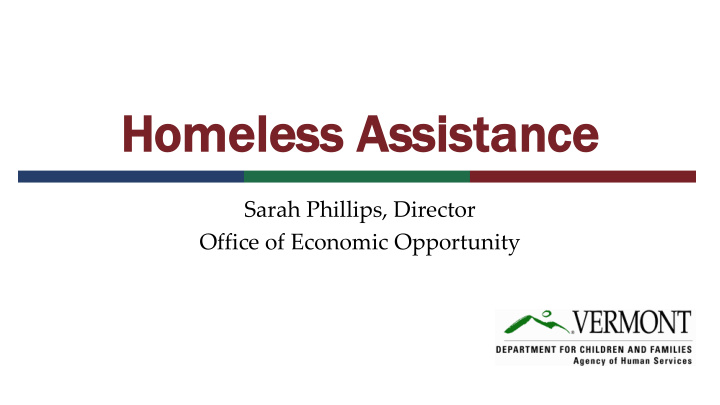



Ho Homele less Assist s Assistance Sarah Phillips, Director Office of Economic Opportunity
Agency of Human Services Independent Living Expanding Community Opportunities for All Ages Affordable Housing Targeting Financial Assistance to Support Stability Transitional Housing Opening Paths from Institution to Community Emergency Shelter Providing a Safe, Emergency response Supportive Housing Customizing Services for Tenants at Higher Risk Homelessness Prevention …and Rapid Re-housing for people who become Homeless
Homeless Assistance – How it All Works State Programs & Resources Structure & Process Funding Housing Opportunity Grant Program Vermont Council on Homelessness Vermont Plan to End Homelessness General Assistance Emergency Continuums of Care (CoC) Housing (Motel Vouchers) Vermont Coalition to End Homelessness Family Supportive Housing Local “CoCs” Vermont Rental Subsidy Chittenden Homeless Alliance Other State-funded/AHS housing Coordinated Entry programs (not homeless specific) Access, Assessment, Referrals, Prioritization HMIS/Point in Time Count
Other AHS Housing Programs (not homeless) Department of Mental Health Subsidy + Care Department of Corrections Transitional and Re-entry Housing Department of Aging & Independent Living SASH Department of Health – ADAP Sober Houses (e.g., Phoenix)
2018 Point-In-Time Count A one-night, unduplicated count of people experiencing homelessness 917 Households – 1,291 People 82 persons were Unsheltered (6% of total persons) 12% Chronically Homeless 8.8% Veterans 774 Single Adults (60% of total persons) 12% Fleeing Domestic or 292 Children (23% of total persons) Sexual Violence 169 Families with Children (39.5% of total persons) 11% People of Color 126 Youth (ages 12-24) (9.8% of persons) 43% Female 6 Minors & 120 Ages 18-24 56.4% Male 26 Parenting Youth HH (15.4% of all families) .6% Transgender
Vermont’s Continuums of Care (CoC) Chittenden Homeless Alliance http://www.cchavt.org/ Vermont Coalition to End Homelessness “Balance of State” (BoS) http://helpingtohousevt.org/ 11 local Continuums of Care under the Coalition umbrella VSHA is not the CoC, but they play multiple roles within the BoS
Local Continuum of Care: Planning & Collaboration Develop ID Assess proactive ID Coordinate common capacity & solutions resources & Link goals to vs reactive ID gaps needed Programs advocate stop-gaps
A Homeless “Continuum of Care”? Housing crisis response system with pathways to permanent housing & links to mainstream resources Outreach Assessment to identify service and housing needs and provide a link to the appropriate level of both Prevention & Diversion Emergency Shelter : immediate, temporary, safe place to sleep Transitional Housing , where appropriate Rapid Re-housing and Permanent Supportive Housing
The Reality Limited resources Definitions: (Literal) Homeless, At-Risk of Homelessness, McKinney Vento definition Targeting resources to those with the most severe service needs/most likely to become literally homeless (again) Gaps in the system of care Waiting lists Housing costs compared to wages Vacancy rates – a statewide problem
Emergency Shelter By design, intended to be temporary, and to help guests move into permanent housing as quickly as possible Variety of forms: congregate facility, motels, seasonal “warming” shelter, scattered site apartments (*best for families*) Unaccompanied Youth: Basic Center, Transitional Living Program Domestic/Sexual Violence Shelters, with some motel overflow, some “transitional”
Homelessness Prevention Prevent homelessness for people seeking shelter by helping them stabilize and preserve existing housing, or identify immediate alternate housing arrangements and, if necessary, connecting them with services and financial assistance to help them return to permanent housing. Limited public “But for this funding but Financial Faith groups assistance”… range of help: Coaching and and Case targeted back rent, Renter 101 Conferencing is prevention and moving help, classes helpful diversion security deposit, rental assistance
Landlord Liaisons Time-limited Subsidies • to the right households (appropriate match) • exit by bridging to affordable housing or increasing in income Service Connection • Housing Navigation and Retention help
(Permanent) Supportive Housing Evidence-based housing intervention that combines affordable housing assistance with wrap- around supportive services for people who need long-term support to maintain independent living. •Long-term Targeted to those with •For individuals – •Shelter + Care Services most severe needs Examples disability is a usually •Always home- •Pathways a threshold based •Chronic Homeless •HUD VASH •Intensive, but •Frequent users of •Family Supported individualized other systems Housing •For families – child welfare involvement
Affordable Housing “Affordable” = Housing costs are < 30% of income (including utilities). Not always true. Services not requisite; income eligibility varies Section 8 (Housing Choice Voucher): project-based, tenant-based Local Affordable Housing Provider: Downstreet, Champlain Housing Trust, Shires, Rural Edge, Windham Windsor Housing Trust, etc Directory of Affordable Housing: http://www.housingdata.org/doarh/
Services to Get & Keep Housing Housing Navigation help to find housing or transition into housing, short-term, focused on connecting household to “mainstream” services (e.g., employment, health, childcare/parent support, income supports) Housing Retention help to sustain tenancy, varies in length, housing- based services
Housing Opportunity Grant Program Funding for community organizations who help people in crisis to find or keep stable, safe housing ~$7 million of state and federal funding Emergency Shelter: Year-round and warming • shelters; day shelters; domestic violence shelters; apartment stays for families Last year 3,872 people Transitional housing for youth & veterans • were sheltered: Homelessness prevention • 2,770 adults & 1,102 children (< 18 years) Rapid re-housing programs • OEO partners with over 40 programs
Family Supportive Housing Program Supportive housing for families experiencing homelessness 7 community providers, ~155 families currently Blend of general fund and Medicaid Program components; Permanent housing (MOU with housing providers) Intensive, home-based services (small caseloads) Financial empowerment support (banking, credit, savings) ~82-90% of participating families are stably housed ~30% of families with Family Services; ~60% with Reach Up
Coordinated Entry – Overarching Goals Reorient system to focus on those Access being served Minimize time and frustration accessing help Assessment Maximize use of system resources Referrals Identify service gaps for planning
Office of Economic Opportunity Sarah Phillips sarah.phillips@vermont.gov (802) 585-9218
Recommend
More recommend